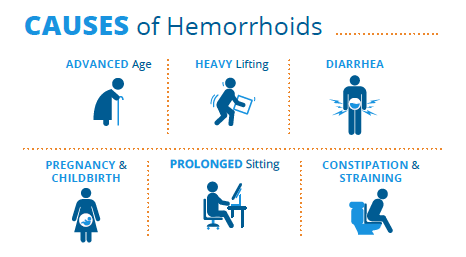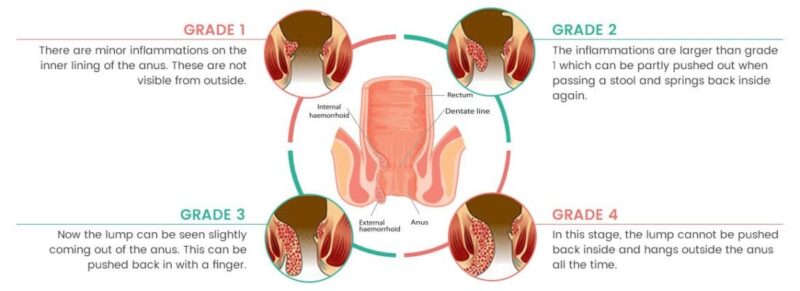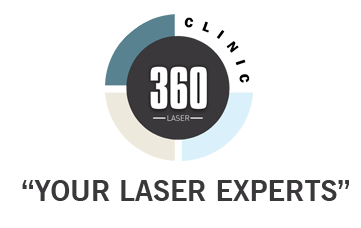What are Piles/Hemorrhoids?
Piles, also known as hemorrhoids, are a very common problem but not many people talk about it and continue to suffer without even seeking medical advice, or trying alternative therapies as they are afraid of surgical procedures. We recommend that you should be upfront about your problem and should not hesitate about talking to a piles treatment expert.
Piles (also known as hemorrhoids) are swollen veins inside your anus and rectum. There is a network of small veins (blood vessels) within the lining of your anal canal. These veins sometimes become wider and engorged with more blood than usual. The engorged veins and the overlying tissue may then turn into piles.
Piles are either internal or external. Some people may develop both internal and external piles at the same time. Internal piles are deeper and initially form above a point 2-3 cm inside the back passage (anal canal) in the upper part of the anal canal. On the other hand, external piles start nearer the surface, below a point 2-3 cm inside the back passage. You should not assume things on your own and talk to your laser treatment experts.
Piles are very much prevalent in India. More than 10 million cases are reported every year. However, one should not be afraid of this disease. It is fully treatable in most cases, usually self-diagnosable without any lab tests or imaging. However, one should not delay getting proper treatment because if not treated, it can be chronic and may last for 12-15 years, maybe lifelong.
What are the symptoms of Piles/Hemorrhoids?
Discomfort is a common symptom, especially during bowel movements or when sitting. Other symptoms include itching and bleeding.
Some people may experience pain in the rectum, pain occurring while sitting, anal discomforts such as itchiness, swelling or bleeding, and constipation.

Further, symptoms of piles may vary based on the type and grade of the piles.
Grade 1 piles are small swellings on the inside lining of the anal canal. They cannot be seen or felt from outside the opening of the back passage. These are very common. In some people, they enlarge further to grade 2 piles or more.
Grade 2 piles are larger. They may be partly pushed out from the anus when you go to the toilet, but quickly spring back inside again.
Grade 3 piles hang out from the anus when you go to the toilet. You may feel one or more as small, soft lumps that hang from the anus. However, you can push them back inside the anus with a finger.
Grade 4 piles permanently hang down from within the anus, and you cannot push them back inside. They sometimes become quite large and painful.
However, to be sure, you do have an opportunity to have a free telephonic consultation from Laser 360 Clinic. you should take an opinion from Your Laser Experts.

What are the complications of Piles/Hemorrhoids?
A possible complication of piles that hang down is that they can ‘strangulate’. This means that the blood supply to the pile has been cut off. A blood clot (thrombosis) can form within the pile. This causes severe pain if it occurs. The pain usually reaches a peak after 48-72 hours and then gradually goes away over 7-10 days. However, this situation may be extremely painful, and one must visit an expert immediately. For more details, please visit the link.
Another possible complication is Anemia. Rarely, chronic blood loss from hemorrhoids may cause anemia, in which you don’t have enough healthy red blood cells to carry oxygen to your cells. Lots of women suffer from this complication, without even knowing the cause of the problem. Women should not suffer in silence and talk to Your Laser Experts!
What are the causes of Piles/Hemorrhoids?
Piles may be caused due to a variety of factors such as constipation, being overweight, pregnancy, aging, hereditary factors, chronic cough, or lifting heavyweights. Any reason due to which pressure in and around the veins in the anus increases, maybe a potential cause of piles.
A medical history followed by a visual examination of the anus is usually enough to diagnose piles. However, a digital examination and Proctoscopy (a scope is inserted to examine the anal canal) is done to confirm the diagnosis. At times, a Barium study or Colonoscopy may be advised if your doctor suspects any other cause of bleeding that needs to be ruled out. However, every person is different, and one should visit an expert. Consult Now.
What should I do to avoid Piles/Hemorrhoids?
To avoid Piles, basically one should try to keep the stool soft, and not put any strain during going to the toilet. Some of the ways to achieve the same may be:
- Drinking lots of fluids. Drink six to eight glasses of water and other liquids (not alcohol) each day to help keep stools soft.
- Eating a fiber-rich diet such as fruit, vegetables, cereals, and wholegrain bread.
- Take Fibre supplements. If a high-fiber diet is not helping, you can take fiber supplements such as spatula, methylcellulose, bran, or sterculia.
- Exercise regularly. Stay active to help prevent constipation and to reduce pressure on veins, which can occur with long periods of standing or sitting. Exercise can also help you lose excess weight that might be contributing to your hemorrhoids.
- Improving toilet habits. Go to the toilet as soon as possible after feeling the need. Do not strain on the toilet.
- Avoid long periods of sitting. Sitting too long, particularly on the toilet, can increase the pressure on the veins in the anus.
These measures will often ease symptoms such as bleeding and discomfort. It may be all that you need to treat small and non-prolapsing piles (grade 1). Small grade 1 pile often settle down over time.
However, if the problem persists, you may try the following options:
- A bland soothing cream, ointment, or suppository may ease discomfort.
- One that contains an anesthetic may ease pain better. You should only use one of these for short periods at a time (5-7 days).
- Preparations that contain a corticosteroid for treating piles may be advised by a doctor if there is a lot of inflammation around the piles. This may help to ease itch and pain. You should not normally use a steroid cream or ointment for longer than one week at a time.
Conclusion:
If nothing works, and the problem persists, you should immediately consult an expert. The expert may be a proctologist, or a general surgeon, or a colorectal surgeon. Piles are very much treatable. However, if treatment is delayed for far too long, and the condition is complicated, then it becomes very difficult to restore the quality of life.
Stop suffering in silence!! Call Your Laser Experts!!



